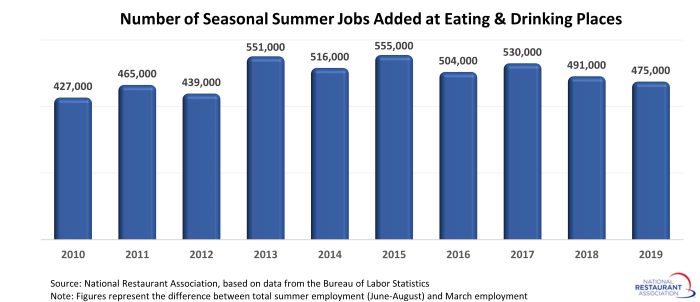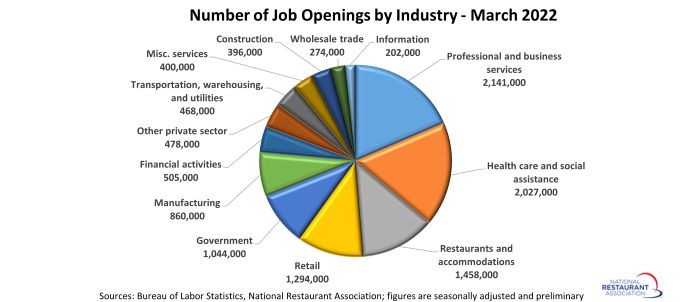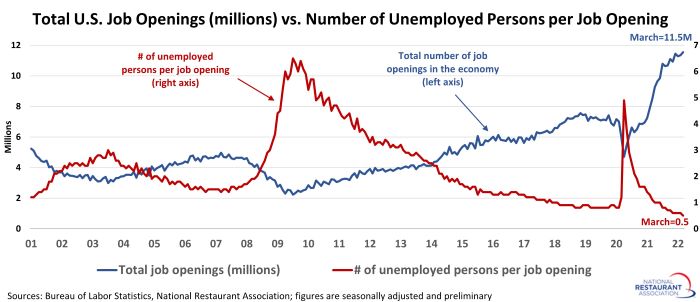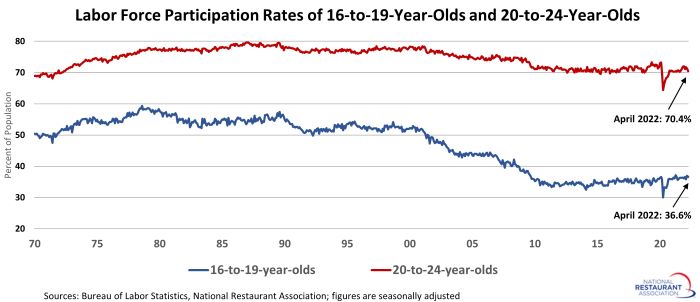What’s the hiring scenario likely to be for employers for summer 2022? A recent research article published by the National Restaurant Association predicts a tight labor market, although it did note the “restaurant industry is expected to expand payrolls this summer” in a continued pandemic recovery and the normal uptick in seasonal jobs.
The May 25 post can be found it its entirety at https://restaurant.org/research-and-media/research/economists-notebook/analysis-commentary/summer-hiring-likely-to-be-challenged-by-a-tight-labor-market/
Memorial Day signals the onset of summer, and restaurants would normally be hiring for the season, bringing on “… a wide variety of individuals – teenagers, college students, teachers – even retirees who want to pick up a few shifts at the 19th hole of their local golf course,” the story said.
Teens and young adults are the likely highest response groups, the story said.
But, it continued, “Many restaurants are still well below normal staffing levels and are working to rebuild their teams back to pre-pandemic levels. Others are seasonal restaurants that do the bulk of their business during the summer months and need to staff up to handle the influx of travelers and tourists.”
Statistically, the restaurant industry generally ranks as the nation’s second-largest seasonal job provider during the summer months, with construction the largest job creator.
Prior to the pandemic, from 2015-2019, eating and drinking places added an average of 511,000 jobs during the summer season, and the states with the highest number of seasonal restaurant jobs created between 2015-2019 were New York (41,000), California (35,400), Massachusetts (28,600), New Jersey (25,800), Texas (24,400), Illinois (22,200), Ohio (18,200), Michigan (17,700), Maryland (15,200) and North Carolina (15,200).
This year, the story said, “Even before most restaurant operators started interviewing for summer jobs, the help wanted signs were out in full force. Many of these positions went unfilled, as job openings rose sharply in recent months.”
It said that there were “nearly 1.5 million [restaurant and accommodations] job openings on the last business day of March 2022, according to Job Openings and Labor Turnover Survey (JOLTS) data from the Bureau of Labor Statistics (BLS),” and although that number has dropped from 1.8 million unfilled job openings d in December 2021, “it was nearly double the typical readings during the months leading up to the pandemic.”
The consensus among restaurant operators is that that the labor pool is very tight, and some 58 percent of operators said in a National Restaurant Association survey that recruiting and keeping employees is “the top challenge currently facing their business.”
And restaurants are not facing that challenge alone. The NRA said that five industry categories had more than 1 million unfilled job openings in March, with professional and business services and health care and social assistance sectors at the top, each with more than 2 million unfilled positions. Retailers reported 1.3 million job openings in March.
“In total, there were 11.5 million job openings in the U.S. economy in March 2022 – the highest level on record. This was 4.5 million (or 65%) more openings than the economy had in February 2020 before the pandemic,” the story said.
And as the need for employees ramped up, “the number of unemployed people available to fill these positions trended steadily lower,” it continued. “As of March 2022, there were only 0.5 unemployed persons per job opening – the lowest level on record. Put another way, there were 2 job openings for every person that was officially categorized as unemployed (which is defined as individuals who are currently not working and are actively looking for a job).”
Looking at the peak of the “Great Recession” of 2009, “there were more than 6 unemployed persons for every job opening in the U.S.,” and the story said that using “these measures, the economy is clearly experiencing the tightest labor market since the beginning of this BLS data series in late-2000.”
Employers should look at teens at a “first place to start” in seasonal hiring, the story said.
“According to data from the U.S. Census Bureau, 55% of teenage restaurant employees work part-year schedules. That’s more than double the 26% of all restaurant employees who only work for part of the year.
“Young adults also have a higher rate of seasonal employment than the overall industry workforce: 29% of 20-to-24-year-old restaurant employees work part-year schedules.
“Taken together, these two age cohorts represented nearly 4 in 10 restaurant employees in 2019 before the pandemic.”
Also, the rising number of teenagers entering the workforce is seen as a “positive force”; and according to BLS data, “there were over 100,000 more teenagers in the labor force in April 2022 than there were in February 2020 before the pandemic began.”
The “next rung up the demographic ladder,” young adults 20-24, have not shown the same numbers in returning to pre-pandemic levels in the labor force, with the BLS reporting 600,000 fewer 20-to-24-year-olds in the labor force in April 2022 than there were in February 2020, “the lowest reading since 2002.”
The story added, however, that lower reading “doesn’t mean this cohort should be written off. Labor force participation rates remain well below historical levels, which suggests there is still potential for growth.”
And it said with teens, “only 36.6%… in April 2022 participated in the labor force, … down from over 52% at the turn of the century… and well below the record high of nearly 60% in 1978.
“At current population levels, if this cohort’s labor force participation rate would rise to 40%, it would mean an additional 600,000 teenagers in the workforce,” the NRA story said.
It said that the “current 70.4% participation rate of 20-to-24-year-olds is nearly 10 percentage points below the record highs reached in the mid-1980s,” and if it were to increase to 73%, “it would add more than 500,000 young adults to the labor pool.”
The takeaway is to “successfully incentivize teenagers and young adults to get off the sidelines and into the workforce this summer,” with a “goal of a fully staffed restaurant” that could be achievable.
For further reference, the associated story graphs and charts are listed below.











